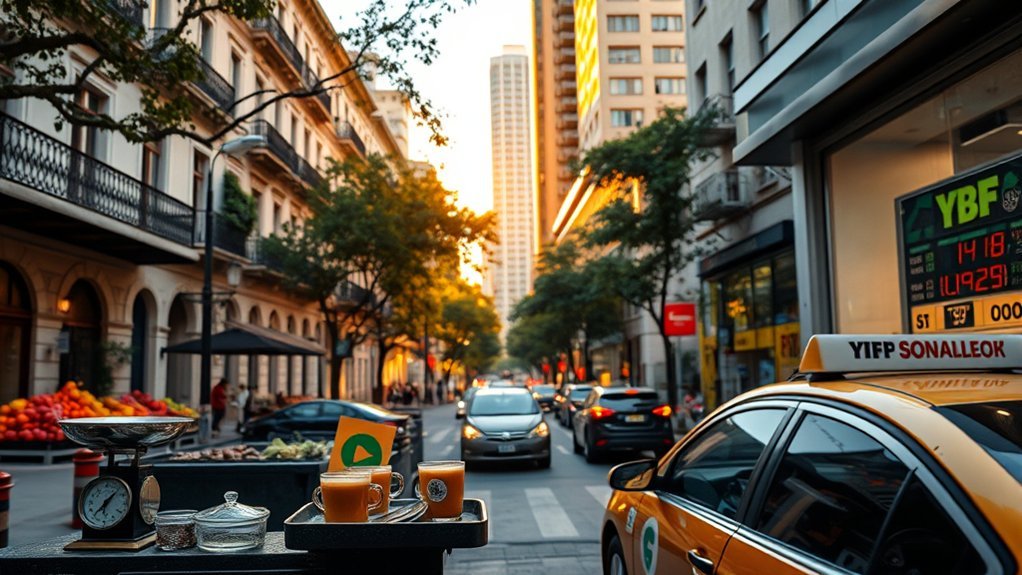You’ll need roughly €870/month as a single and about €2,750/month for a family of four to sustain a typical mid‑range lifestyle in Argentina. Rents dominate budgets — one‑bedroom central units average ~$325/month while outskirts are cheaper — and groceries, utilities and transport are relatively low. Average net wages (~€485/month) leave many singles with a shortfall unless they earn in stable foreign currency. Keep going to see detailed costs and budgeting strategies.
Overview of Average Costs and Living Standards in Argentina
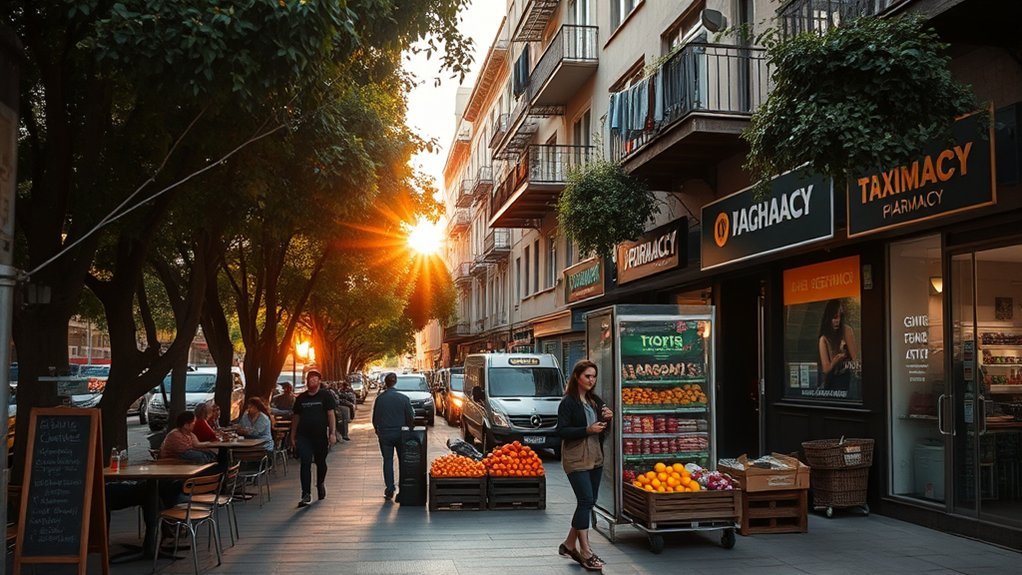
Reflecting recent data, living in Argentina is relatively inexpensive by global standards but highly sensitive to location and income source: the national cost-of-living index stood at about 29.4 (April 2025), with Buenos Aires and other large cities pushing averages upward.
You’ll find the average cost of living for a single person is roughly €870 monthly, while a family of four needs about €2,750.
Consumer prices show variability: an inexpensive restaurant meal runs about $8, a McMeal $6, a gallon of milk $3.95, and a loaf of white bread $1.28, reflecting city-to-city differences.
Rent markedly influences budgets, so your total spending profile depends on accommodation choices and local market conditions.
Given an average net monthly salary near €485 (~$450), affordability hinges on whether your income is indexed to inflation or earned in a stronger currency.
You should assess income stability and currency exposure when projecting living standards and budget resilience.
Housing and Rent: What to Expect by City
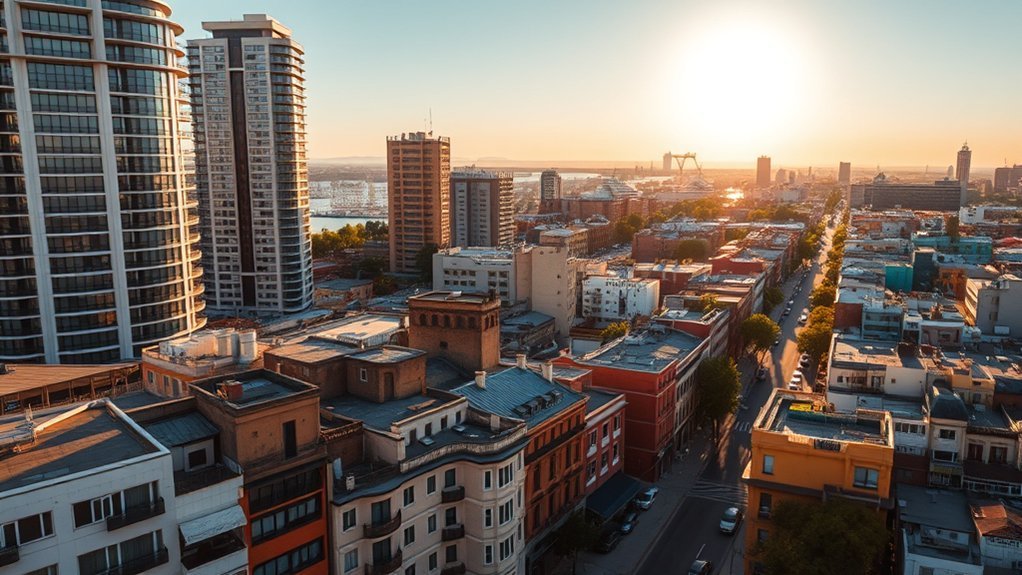
Although costs vary by neighbourhood and city, rent in Argentina remains low by international benchmarks and will likely be your biggest monthly expense, especially in Buenos Aires where a one‑bedroom in the centre averages about $325/month (range $150–$600) versus roughly $235/month outside centre (range $120–$450).
Rent in Argentina stays low by global standards; expect one‑bedrooms around $325 central and $235 peripheral.
You’ll find a three‑bedroom in Buenos Aires city center averages about $579/month (range $285–$1,250) and roughly $423/month (range $200–$968) outside centres.
April 2025 rent indices place major cities (Buenos Aires, La Plata, Lanús, Córdoba) at ~11.7, signalling consistently lower rents internationally.
Local reported values list one‑bedroom rents near AR$588,000 centrally and AR$385,000 on outskirts after 2023 liberalisation—useful for short‑term budgeting and forex scenarios.
If buying, expect city‑centre prices around $183/ft² (range $111–$327) and $139/ft² outside (range $83–$232).
When renting an apartment, compare centre versus periphery systematically: factor unit size, neighbourhood safety, transport access and currency exposure to optimise cost and value.
Food, Groceries, and Eating Out Prices

You’ll find that typical grocery prices in Argentina are generally low—milk is about $3.95 per litre, a 500 g loaf of white bread around $1.28, and a dozen eggs about $1.80—contributing to a single-person monthly budget near €870.
Eating out remains affordable too, with inexpensive restaurant meals averaging $8.00 (range $4–$14) and fast-food McMeals around $6.00, while leisure items like a bottle of wine (~$3.50) and cinema tickets (~$4.37) are also relatively cheap.
Compare markets with supermarkets and you’ll see fresh produce and meat (chicken ~€6.70/kg, potatoes ~€1.10/kg, cheese ~€10.25/kg) often cost less at local markets, affecting total food spend and the national cost-of-living index (≈29.4, April 2025).
Typical Grocery Prices
Typically, grocery and dining costs in Argentina sit well below North American and many European averages, with an inexpensive meal usually around $8 (range $4–$14) and a McMeal about $6 ($5–$8).
For groceries, prices vary depending on product type and region: a litre of milk averages $3.95 ($1.97–$6.06) and a 500 g white bread loaf about $1.28 ($0.45–$3.63).
A dozen eggs cost roughly $1.80 ($0.80–$3.00).
Protein and dairy show variability: chicken fillet is reported near €6.70/kg and local cheese around €10.25/kg.
Consumer-level entertainment and beverage items are low-cost (cinema ≈ $4.37, beer variable).
You’ll find local produce and meat offer particularly strong value versus Western benchmarks.
Eating Out Costs
Generally, you’ll find eating out in Argentina is considerably cheaper than in North America and much of Europe: an inexpensive restaurant meal averages about $8 (range $4–$14) and a McMeal runs roughly $6 ($5–$8).
You should expect eating out costs to vary substantially by city and venue; casual local restaurants align with the low end, while upscale venues can cost several times more.
Because grocery staples—milk ~$3.95/gal, bread ~$1.28/loaf, eggs ~$1.80/dozen, chicken fillet ~€6.70/kg—and local beef and wine remain affordable, your overall Cost of regular meals is reduced when you combine occasional dining out with home-prepared items.
Budget planning should factor in location-specific premiums and exchange-rate fluctuations.
Market Vs Supermarket
When weighing markets against supermarkets in Argentina, compare unit prices, seasonality, and venue premiums: an inexpensive restaurant meal averages about $8 (range $4–$14) and a McMeal about $6 ($5–$8), while supermarket staples—milk ~$3.95/gal, bread ~$1.28/loaf, eggs ~$1.80/dozen—set baseline grocery costs.
You should treat local markets as a variable-cost strategy: seasonal produce and local proteins (potatoes ~€1.10/kg, chicken fillet ~€6.70/kg) frequently undercut supermarket prices, improving per-meal economics.
Supermarket staples provide predictable pricing and bulk discounts but carry venue premiums in major cities.
Eating at inexpensive local restaurants often competes with supermarket-prepared meals on price and convenience.
For budgeting, model grocery spend using a mix of markets for fresh items and supermarkets for staples.
Transportation, Utilities, and Connectivity Costs

Although public transit is widely the most cost-effective option, you’ll find a one-way local ticket usually costs about $0.30 (range $0.20–$0.72) while monthly passes average roughly $15.00 (range $7.06–$28.00), and in Buenos Aires subsidised Subte/bus fares vary by usage with card trips falling into different ARS buckets; by contrast, gasoline at about $3.45 per gallon (range $2.27–$4.54) makes car travel noticeably more expensive than transit in most cities.
When evaluating living in Argentina costs, factor transit as your baseline commuter expense: many long-term residents buy monthly passes to minimize per month spending. Utilities for a 915 sq ft apartment average $48.67 per month (range $25.50–$100.00), which is low relative to comparable markets.
Connectivity is affordable: home internet (≈60 Mbps) costs about $18.76 per month (range $10.00–$38.00) and mobile plans average $14.97 monthly (range $6.00–$25.00).
Aggregate these items to estimate predictable recurring expenditures and compare scenarios (public transit vs car ownership) for budgeting accuracy.
Healthcare, Insurance, and Education Expenses
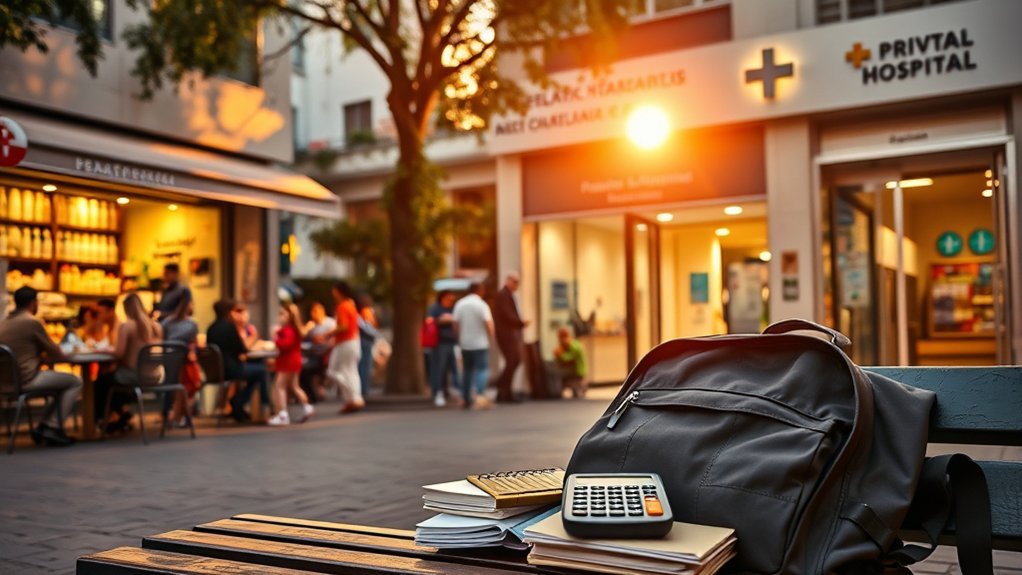
You’ll find public healthcare free for residents, but routine private consultations typically cost ARS 20,000–40,000 (≈€15–€40) and private hospital nights about ARS 128,360 (≈€120), so many households weigh out-of-pocket vs. insurance expenses.
Private health insurance premiums commonly run ARS 100,000–400,000 (€110–€440) annually, which, combined with frequent specialist fees of ARS 32,000–58,800, can materially raise your annual healthcare budget.
On education, private preschool averages ARS 230,000/month while international primary schools range ARS 1,810,000–10,690,000 per year, meaning opting for private/international options substantially increases household costs compared with public alternatives.
Healthcare Costs and Access
Because Argentina maintains free public healthcare for residents, you’ll often weigh cost against speed and scope of services when choosing care. You can rely on public hospitals for most needs, but many opt for private clinics or health insurance to reduce wait times and access specialists.
Private visit and stay sample prices illustrate trade-offs:
- GP visit: ARS 16,000–26,750 (€15–€25); specialist: ARS 32,000–58,800 (€30–€55).
- Annual private health insurance: ARS 100,000–400,000 (€110–€440) depending on coverage; hospital night ≈ ARS 128,360 (€120).
- Telehealth viability depends on utilities: internet ≈ ARS 22,460/month; mobile ≈ ARS 17,115/month.
You should model expected out‑of‑pocket plus insurance premiums to decide most advantageous coverage.
Schooling and Tuition Fees
Education is one of the largest controllable household expenses in Argentina, and you should budget carefully for preschool through secondary options because costs vary widely by type and quality. You’ll find private preschool averages about €215/month (≈ ARS 230,000) with €60–€349 ranges. International primary school tuition shows high variability: €1,200–€7,200+ annually or €1,430–€1,496/month at some schools. Top international K–12 institutions charge €1,870–€1,980/month for secondary, so international schooling is a major recurring cost. Public healthcare consultation fees are modest, but many families with international school students add private health insurance for broader coverage.
| Level | Typical cost range |
|---|---|
| Private preschool | €60–€349/month |
| International primary/secondary | €1,200–€10,000+/year |
Leisure, Clothing, and Major Purchases

Leisure and discretionary purchases in Argentina are generally affordable relative to many Western countries: a monthly gym membership averages about $20.05 (range $10–$35), cinema tickets run near $4.37 (range $3–$9), and mid-range cultural events (e.g., Teatro Colón) can cost roughly ARS 26,740 (≈ $25) depending on the show.
Leisure in Argentina is surprisingly affordable—cheap gym memberships, low-cost cinema tickets, and reasonably priced cultural events.
If you’re Per,moving to Argentina you’ll find routine entertainment and consumables low-cost, though major durable goods carry higher sticker prices. Quantitatively:
- Clothing and footwear: Levi’s jeans ≈ $72.41 (range $30–$140); Nike running shoes ≈ $108.84 (range $60–$190).
- Consumables: mid-range bottle of wine ≈ $3.50 (range $2–$7.50); 20 cigarettes (Marlboro) ≈ $2.00 (range $1.50–$3.65).
- Major purchases: new compact cars (VW Golf/Toyota Corolla) ≈ $25,000 (range ~$19,000–$32,765).
You can thus budget for low ongoing leisure costs but must plan for substantially higher one-time expenditures on automobiles and other durables.
Salaries, Budgeting Tips, and Affordability Comparison
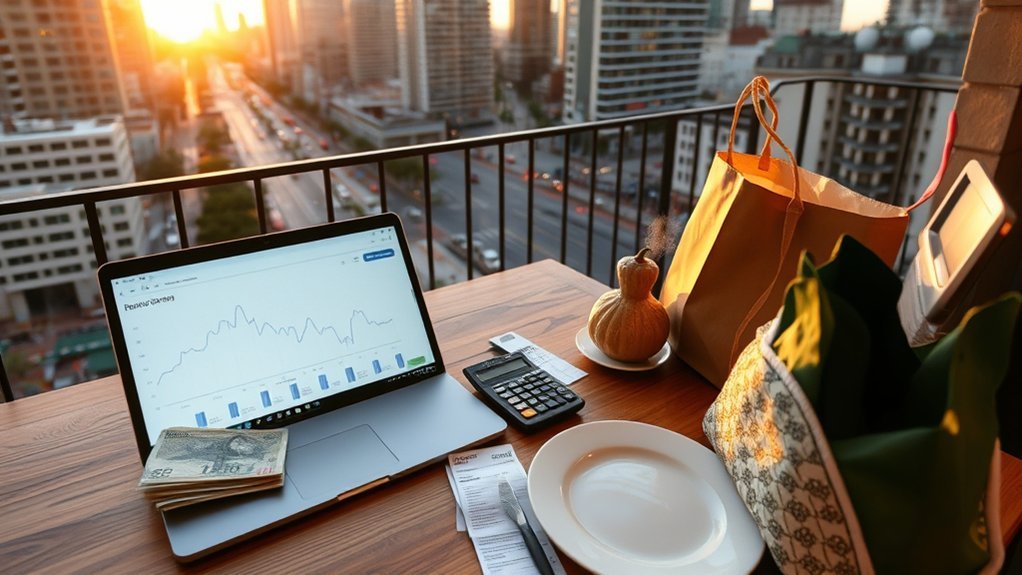
While average net monthly pay in Argentina sits at roughly $450 (≈ €485), typical living costs—about €870 for a single person and €2,750 for a family of four—mean many workers lack sufficient disposable income without supplementary earnings or savings.
You should consequently treat the €870 monthly cost for a single person in Argentina as a baseline that exceeds median net wages, implying a budget gap of roughly €385 monthly.
Rent is the dominant variable: one‑bedroom city‑centre units in Buenos Aires run about $325–$550, so choosing outside‑centre options materially lowers housing share of spend.
Given inflation and currency instability, earning or holding dollars stabilises purchasing power; many workers seek dollar‑linked contracts or remittances.
Regionally, Argentina’s cost‑of‑living index (~29.4) is lower than Uruguay’s but higher than Paraguay’s, so affordability hinges on local wage levels as much as nominal prices.
You should prioritize housing, diversify income, and denominate savings in stable currency to maintain real living standards.
Frequently Asked Questions
Can I Live in Argentina as an American?
Yes — you can live in Argentina as an American; you’ll need an appropriate temporary or permanent visa, register with Migraciones, obtain a DNI for services, and plan finances wisely due to inflation, currency volatility, and employment legalities.
Can You Live on $1000 a Month in Argentina?
Yes — you can live on $1,000/month in Argentina; data shows typical single-person budgets of $870–$1,000 cover modest rent, utilities, transport and groceries, though location, inflation and lifestyle critically affect viability and require cautious budgeting.
Is It Cheaper to Live in Argentina Than the US?
Yes — you’ll generally pay far less in Argentina: overall costs run about 60–70% lower than many U.S. cities, with much cheaper rent, food, transport and utilities, though imported goods and private services can match U.S. prices.
What Is the Average Price of a House in Argentina?
The average house price in Argentina varies: city‑centre apartments average about $183.05 per sq ft (≈ $1,970/m²), outside centres about $138.76 per sq ft (≈ $1,490/m²); expect wide regional and mortgage‑rate impacts.
Conclusion
You can live in Argentina comfortably on a modest budget: average monthly rent for a one-bedroom in Buenos Aires runs about USD 350–500, and groceries for a single person typically cost USD 150–250. With that in mind, aim for a monthly budget of roughly USD 700–1,200 depending on city and lifestyle. Note that Argentina’s median monthly salary is about USD 400, so comparing income to a USD 900 living-cost midpoint highlights affordability pressures for many residents.

